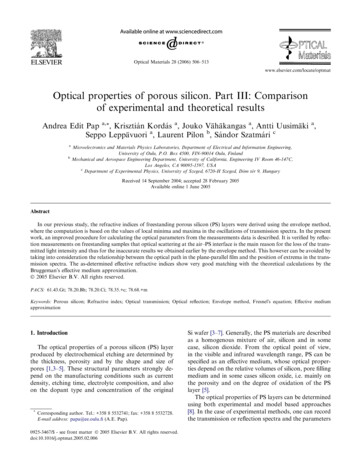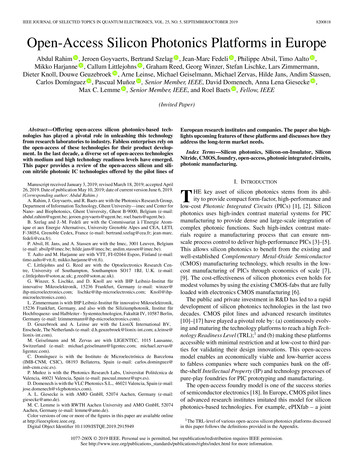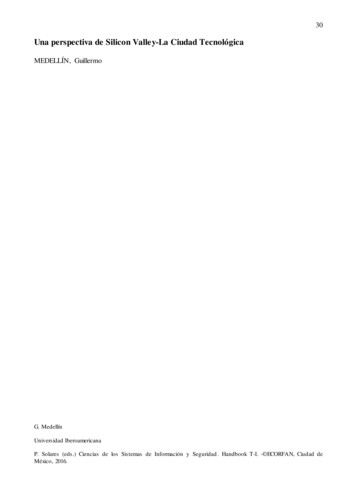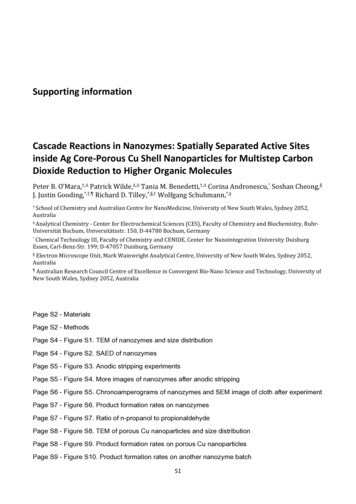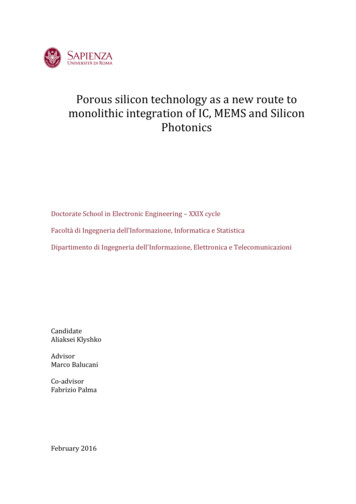
Transcription
Porous silicon technology as a new route tomonolithic integration of IC, MEMS and SiliconPhotonicsDoctorate School in Electronic Engineering – XXIX cycleFacoltà di Ingegneria dell’Informazione, Informatica e StatisticaDipartimento di Ingegneria dell'Informazione, Elettronica e TelecomunicazioniCandidateAliaksei KlyshkoAdvisorMarco BalucaniCo‐advisorFabrizio PalmaFebruary 2016
AbstractThe scope of this thesis research is validation of the technological steps of the novelapproach for universal platform for integration of silicon photonics (SP) with integratedcircuits (IC) and MEMS based on the standard CMOS wafers and technology.Current state of the art of silicon photonics is analyzed with the focus on the mostpopular configurations for passive devices. Advantages and drawbacks of using industrial SOIwafers for silicon photonics components are given and possibility of using the popularSMARTCUT SOI platform for monolithic integration of SP and IC is analyzed. A conclusionis made on the controversial requirements to the universal platform from the point of view ofphotonics and electronics. A review of the alternative approaches existing for patterned SOIsubstrates is carried out including SIMOX and FIPOS. Suitable starting platforms forlocalized isolation based on porous silicon process are critically reviewed.Peculiarities of porous silicon fabrication on wafers of various doping are explainedfrom the point of view of chemical, electrochemical reactions as well as the influence ofdoping level of the initial silicon substrate is given. Changes of optical properties of poroussilicon and oxidized porous silicon with respect to the bulk silicon are explained by effectivemedia approach. Conclusions are made for suitability of porous silicon and oxidized poroussilicon for silicon photonics applications.Various approaches for porous silicon localization are reviewed. Two main types ofexisting masking technologies for porous silicon localization are compared includingdiffusion and ion implantation. Advantages obtained from using low-energy ions are given.Peculiarities of porous silicon fabrication on the low-doped p-/p CMOS wafers arestudies. Possibility of using proton implantation for fabrication of SP components withsubmicron resolution is checked. A process flow for fabrication of single-mode waveguidesbased on selective SOI by porous silicon using proton implantation is proposed and steps ofthe process are separately validated. Detailed explanation of the results is given.A novel modeling approach for porous silicon process on complex doped wafers usingSilvaco TCAD is proposed. Possibility of creation a self-stopping porous silicon process bymeans of the top-layer exploiting the selectivity of porous silicon to doping layer is deducted.Two kinds of novel structures with stop-layer (n /n-/p-/p and p-/n-/p ) for restricting theporous silicon are proposed. Analysis by numerical simulations is made showing thefeasibility of complex doping structures for effective stop-layer creation and potentialapplicability of the developed simulation approach.
ContentsIntroduction . 51 Silicon photonics key components . 61.1 Passive silicon photonics components . 61.2 Losses . 81.2.1 Volume scattering losses . 81.2.2 Sidewall scattering losses . 81.2.3 Radiation losses .111.2.4 Absorption losses .12Summary of the chapter 1 .152 On the way to localized SOI .172.1 SIMOX .182.2 FIPOS .19Summary of the chapter 2 .203 Porous silicon as optical material .213.1 Discovery and applications .213.2 Optical properties of porous silicon .243.3 Oxidized porous silicon .253.4 Scattering in porous silicon and oxidized porous silicon .273.5 Notes on oxidation of porous silicon.283.6 Single mode fiber coupling using porous silicon structure .29Summary of the chapter 3 .324 Nature of silicon dissolution .334.1 Chemistry and thermodynamics .334.2 Porous silicon in practice .364.3 Porous silicon dissolution roughness .38Summary of the chapter 4 .395 Localization of porous silicon .405.1 Planar masking approach .405.2 Three-dimensional masking approach.425.2.1 Masking by doping .425.2.2 Masking by proton implantation .44Summary of the chapter 5 .476 Validation of technology .48
6.1 Localized SOI as an optical waveguide .486.2 Choosing the WG geometry .496.3 Roughness for SOI waveguides .516.4 Porous silicon on CMOS wafers .526.5 Optical characterization of oxidized porous silicon on CMOS .576.6 Testing of proton implantation on the CMOS wafers .626.7 Localized formation of waveguides CMOS wafers .636.8 Explanation of the results .696.8.1 Diffusion limitations .696.8.2 Carrier transport around irradiated areas .70Summary of the chapter 6 .727 Modeling of the Silicon/HF interface.747.1 Semiconductor to electrolyte interface .747.2 The energy levels in the electrolyte.757.3 Basic theory of the charge transfer .757.4 Limitations of the Basic Theory .777.5 Simulation of charge transfer through the Silicon-HF interface .78Summary of the chapter 7 .838 Self-stopping anodization process .858.1 A n /n-/p- structure .858.1.1 Sample fabrication.868.1.3 Test anodization .878.2 A p-/n-/p structure .90Summary of the chapter 8 .93Conclusions .95References .97
IntroductionAs the current computing increases the computational power higher and higher datarates and bandwidths are required. The standard copper interconnects are no longer capable toprovide the required bandwidths even within chips. The current technology is inevitablyundergoing the switch from electrical to optical interconnections virtually having nopredictable limit in data transfer rates and we now speak of photonic integrated circuits. Themeaning of photonics is in analogy with electronics and reflects the growing tie betweenoptics and electronics. While electronics deals with the control over the electric-charge flow,photonics involves the control over photons. The two disciplines clearly overlap since thecontrol over the electrons often controls the flow of photons and vice versa. The termphotonics also reflects the importance of the photon nature of light in describing the operationof many optical devices. Current silicon photonics technology is still at a maturity levelsimilar to the one of the electronics industry in the 1980s. In order to manufacture morepowerful and cheaper chips beyond the Moore’s law, it is desirable to integrate multiplefunctions, such as processors and memories, which were previously implemented as multiplediscrete chips, into a single chip to realize system-on-a-chip. Transition between discretecomponents and the integrated system is occurring, allowing us to respond to the need forcost-effective systems.The existing CMOS processes can be successfully implemented for shaping the siliconfor fabrication of various photonics devices. The majority of the devices can be relativelyeasily realized within the silicon wafer or using the silicon, others can be potentiallyintegrated on a silicon chip in terms of single device. In the silicon CMOS industry,performance improvement and new functionalities (application range) usually comes from thescaling of dimensions. Since the performance improvement of photonics will not come fromsuch a scaling (fundamentally limited by the optical wavelength), it has to come from theprocess integration possibilities. Complex integration solutions can be used to resolve some ofthe several challenges of silicon photonics. First, the integration of electronics and photonicsneeds to be compliant with the CMOS technology roadmap. If a monolithic integration ofphotonics into electronics has been demonstrated, this approach is not the most efficient interms of overall effort with regard to advanced CMOS nodes for the electronic part. Solutionssuch as 3D or 2.5D integration using a copper pillar allows for the separation of bothelectronic and photonic processes and opens the door to a fully dedicated process optimizationfor the photonics die.The limitation of the device performance is resulting from the trade-off between theavailable SOI wafer structure and processing (limited by initial SOI and buried oxide (BOX)thicknesses, the number of mask levels and the process dispersion) and the optimal design ofthe various components (e.g. waveguides, grating coupler, and modulator) that would usuallyrequire several different Si-thicknesses. Another challenge is the optical performance of theindividual components. For example, fully integrated Si-photonics is not yet able to performthe complex functions of high-end discrete-component-based circuits such as densemultiplexing/de-multiplexing, mainly due to the need for thermal control of the Si-baseddevices.Alternative CMOS compatible technologies must come to the market that will allowthe monolithic integration for silicon photonics components.5
1 Silicon photonics key components1.1 Passive silicon photonics componentsThe optical waveguide can be considered as an essential building block of any siliconphotonics system and its production is one of the bottlenecks in the monolithic integrationusing standard substrates for industry. From one hand undoped silicon is transparent startingfrom the near IR range of optical spectra covering the main wavelengths used for opticalcommunication. This makes a silicon substrate an attractive platform for integration of opticalinterconnection link. On the other hand in order to have a waveguiding effect due to totalinternal reflection, a silicon core with refractive index (RI) close to 3.5 (figure 1.1) must besurrounded with the media with lower refractive index. The higher is the RI jump, the better isconfinement and smaller can the waveguide be.Figure 1.1 – Absorbance and refractive index of undoped silicon [1]The first silicon waveguides were presenting a structure of intrinsic silicon on top ofsilicon wafer with high doping has been demonstrated back in 1985 [2]. In this processepitaxial layer of low doped silicon was used as a guiding media for creating slab waveguidesfor 1.3 and 1.55 μm. The RIE process was used to obtain the required geometry of the core(figure 1.2).w 10 um14-319-3Si epiND 9x10 cmSi bulkND 3x10 cmFigure 1.2 – Waveguides based on intrinsic silicon epitaxial layer [2]The waveguide structures represented low-doped n or p layers on highly dopedsubstrate. The large concentration of donors (or acceptors) in the substrate produced freecarrier dispersion that decreased the refractive index of the substrate relative to the index ofthe epitaxial layer. The refractive index difference was reaching 10-3 10-1 that was sufficientto obtain the confinement. Low n imposed the minimum dimension of the core to 10 μmwidth and optical losses were as high as 15 dB/cm mainly due to radiation loss. By processoptimization the losses were believed to be decreased.6
The emergence of the SOI platform at the end of 80s at first for electronic devicesgave a huge rise to the silicon photonics and has become the most popular platform forrealizing passive SP components. The SOI stacked structure (figure 1.3) is by its naturesuitable for silicon photonics. Indeed in SOI wafer the crystalline silicon film (TopSi) isisolated from the substrate by a thin layer of SiO2 so-called buried oxide (BOX) and contactswith air on top. Both SiO2 and Air having low RI giving the high contrast to the waveguideand allowing submicron dimension. As SOI is extensively used in the microelectronicsindustry, it is one of the most promising materials for optical/electrical integration.Figure 1.3 – Silicon-on-insulator (SOI) waferThe research in waveguiding in silicon started with planar waveguides and continuedwith large rib waveguides. Recently, there has been a trend to reduce waveguide dimensionsand consequently both small rib and strip waveguides have been investigated [3]. The mostpopular structures of the waveguides based on SOI are strip, rib (or ridge) and slotwaveguides (figure 1.4). Some groups experiment with photonic crystal waveguides.Top SiO2Top SiO2Strip waveguideRib/ridge waveguideTop SiO2Photonis crystal waveguideSlot waveguideFigure 1.4 – Types of SP waveguides realized on SOI substratesTypical loss values determined by geometry and fabrications conditions were reportedto be are 2 3 dB/cm for single-mode strip waveguides, 0.1 dB/cm for large rib waveguides,3 4 dB/cm for photonic crystal waveguides.7
1.2 LossesOptical losses of the silicon waveguide showing the decay of the signal propagatingthrough the waveguide is one of the main characteristics of the passive silicon photonicsdevices. The main contributors of loss in an optical waveguide are scattering, absorption andradiation.1.2.1 Volume scattering lossesThe scattering may result from two sources: volume scattering and interface scattering.Volume scattering is caused by imperfections in the bulk material, such as voids, contaminantatoms, or crystalline defects that locally change optical properties of the material. Interfacescattering is due to roughness at the interface between the core and the claddings of thewaveguide. In ideal case volume scattering for silicon photonics based on SOI wafers isnegligible and the main loss come from interface scattering arising due to processing steps(like etching) natural fluctuations and upon shrinking the dimensions can be significant evenfor relatively smooth interfaces.From another side one might reasonably be concerned that volume scattering could bea contributor to optical loss, since in several of the fabrication techniques used to produce SOIwafers the potential exists for the introduction of defects, notably via ion implantation. It hasbeen shown that the contribution to volume scattering is related to the number of defects, theirsize with respect to the wavelength of propagation, and the correlation length along thewaveguide. In bulk media, Rayleigh scattering is the dominant loss mechanism, whichexhibits a λ 4 dependence. However, for confined waves the wavelength dependence is relatedto the axial correlation length of the defects. For correlation lengths shorter than or of theorder of the wavelength, the volume scattering loss exhibits a λ 3 dependence, because thereduction of confinement for longer wavelengths partially counters the λ 4 relation. For longcorrelation lengths compared to the wavelength, radiation losses dominate and λ 1 dependenceis observed.Taking this into account volume scattering should always be considered for compositematerials systems as well.1.2.2 Sidewall scattering lossesSilicon–silicon dioxide (Si–SiO2) waveguides benefit from a large refractive indexdifference, inducing a high electromagnetic field confinement in the silicon guiding layerwhich in turn allows reducing the waveguide size to submicrometer values. In order to useSOI waveguides for optical communications, both polarization insensitivity and single-modepropagation should be simultaneously fulfilled. These conditions can be achieved by usingdeeply etched rib SOI waveguides with dimensions in the order of 1 um. At the same time asthe waveguide dimensions shrink towards below the micrometer range, materials providinghigh contrast of the RI between the core and walls are used, the optical energy is becomingmore confined. For such a high contrast waveguide the sidewall roughness (figure 1.5) startsto become the main contributor to the overall optical loss. Several compact devices have beenobtained with square-strip waveguides provided a square size smaller than 320 nm at 1.55 μmto insure single-mode condition. Unfortunately due to the reactive ion etching (RIE)parameters of those devices generally degrade because of increased sidewall roughness.8
Figure 1.5 – Waveguide sidewall roughnessThe surface roughness is characterized by two main parameters: a correlation lengthLC and mean square deviation σ. The authors of [4] have deducted that in general we find that,independent of the detailed statistics, the scattering loss will have an upper bound given byequation,(1.1)where σ is the standard deviation of the roughness, k0 is the free space wave vector, d is thehalf width of the waveguide, and n1 is the index of the core, κ is parameter depending on thedistribution statistics (κ 0.48 for exponential distribution and κ 0.76 for Gaussian).Experiments were shown to be in a good agreement with theory [5] while theperformance of a Si/SiO2 strip waveguide as a high n system was measured as waveguideand processing parameters have been changed. To make Si/SiO2 waveguides with a singlecrystalline core, UltrabondTM SOI wafers with 200 nm thick TopSi layer on 1 μm thick silicondioxide BOX were used. Wafers were patterned by photolithography and reactive ion etchingprocess was used to obtain strip waveguides. Straight waveguides of width varying from 0.5to 8 μm were made using the same technological process steps and losses evaluated.Supposing the same roughness value for all the waveguides, an increase of loss was found asthe dimensions shrunk down (figure 1.6).Figure 1.6 – Cross-section of the strip waveguides from [5] and related transmission lossA numerical study performed in the work [6] was used to describe the propagation lossinduced by sidewall roughness in square SOI strip waveguides in even smaller sub-micronwaveguides. It was found that propagation loss strongly depends on the cross-section and caneven decrease when the size is extremely reduced, due to a lower optical confinement. Forexample It has been shown that for a 150x150 nm cross-section and with roughness9
parameters such as σ 2 nm and LC 50 nm, propagation loss as low as 0.5 dB/cm can beexpected.Figure 1.7 – Calculated propagation loss for the waveguide of 150 500 nm and variousroughness parametersPropagation losses were found to be strongly correlated to field confinement andexhibited the maximum for a 260 x 260 nm waveguide. It has also been shown that it may beadvantageous to use 200 x 200 nm waveguides instead of 320 x 320 nm as the propagationloss are reduced by a factor larger than two without a significant widening of the guidedmode. The smallest structures are quite useful for three-dimensional (3-D) tapers designed forlow loss coupling between polarization insensitive waveguides and single-mode opticalfibers.Both LC and σ are contributing to total loss (figure 1.8). Most smoothing techniques,based on minimizing the surface area, tend to reduce σ while maintaining or increasing LC.Processes that reduce both LC and σ are favored to achieve lowest losses.Figure 1.8 – The propagation loss induced by sidewall roughness calculated for 500 x 200 nmrectangular cross-sectional Si–SiO2 waveguidesFor example, by reducing LC to 10 nm and σ to 1 nm, scattering loss lower than 0.1dB/cm can be obtained. These values are possible in principle since atomically smooth 4 Åsurfaces have been obtained for example during single-crystalline silicon etching incrystallographic etchants like KOH. Use of an oxidation step or anisotropic etching as anaddition to a RIE etching was found to be feasible to reduce the sidewall roughness of SOIwaveguides as well.10
1.2.3 Radiation lossesThis type of losses implies leakage from the waveguide into the surrounding media(typically the upper or lower cladding), or for a rib waveguide, also into the planar regionadjacent to the guide. Loss of energy due to radiation for a straight optical waveguide shouldideally be negligible. If the waveguide is well designed this loss will not normally besignificant, although unwanted perturbations in the waveguide due to, for example, a damagedfabrication mask may cause scattering of light from one mode to another that may in turnresult in some radiative loss if that mode is leaky.Another situation for radiative loss is bending of the waveguide, as this will changethe angle of energy incidence at the waveguide wall, which in turn will result in someradiative loss. Higher confinement is required for smaller bending radii.For a multilayer waveguide structure such as the SOI waveguide, the radiative lossesexist as soon as waveguide cladding thickness is finite. The buried oxide layer must besufficiently thick to prevent optical modes from penetrating the oxide layer and coupling tothe silicon substrate. Clearly the required thickness will vary from mode to mode, as eachmode penetrates the cladding to a different depth. Furthermore, the penetration depth alsovaries with the waveguide dimensions with respect to the wavelength of operation. In the caseof SOI waveguides, with a micrometer thick TopSi layer the buried oxide thickness needs tobe at least 0.4 μm for operation in the wavelength range 1.3 1.6 μm, to prevent significantloss (figure 1.9).The trend in silicon photonics is to move to smaller waveguide structures for spaceand efficiency advantages. As the waveguide dimensions reduce, however, the effective modeindex is decreased and the mode is becoming less confined with mode tails extending furtherinto the cladding. In order to ensure that miniaturization is not compromised by higher lossthicker BOX is necessary.Figure 1.9 – The BOX thickness required to reach 0.001 dB/cm radiation lossFigure 1.9 shows how the required buried oxide thickness of a planar SOI waveguidestructure varies with a varying waveguide thickness, to maintain a loss to the substrate of lessthan 0.01 dB/cm of the fundamental mode. It is interesting to note the polarizationdependence even at large waveguide thicknesses. This is not usually an issue because theoxide is simply made thick enough to fully confine both polarizations.11
Figure 1.10 shows calculated loss for the main TE-like mode of the optical stripwaveguide due to radiation to BOX for various waveguide width. The thickness of the TopSiis considered 220 nm.Figure 1.10 – Influence of the BOX thickness or radiation loss depending on the waveguidewidth. Top silicon thickness is 220 nm.If the thickness for the TopSi is low, for lower width waveguide the mode is lessconfined and radiation due to the limited BOX thickness becomes more pronounced. For220 nm device layer waveguide, a 200 nm BOX will lead to incredible attenuation of 100dB/cm. This value of attenuation is not practical even considering short transmission lengths.In order to keep the substrate leakage at a reasonable level the thickness of the box shouldexceed 650 nm if the target is 1 dB/cm, or potentially even 1 1.2 μm for lower losses.1.2.4 Absorption lossesIn semiconductors optical energy is mainly absorbed by interactions with chargecarriers both stationary and free [7]. Following electron states must be taken into account:electrons from valence band, electrons internal shell free charge carriers (electrons and holes)and electrons related to localized impurities centers or defects (Figure 1.11 a, b and c).Ecħυħυ EGħυEcEG ħυ EIEIEVEVabEcAll ħυħυEVcFigure 1.11 – Absorption mechanisms in semiconductorsThe main absorption mechanism for semiconductor is the interaction of the first typerelated to the transfer of electrons from the valence band to conduction band through theforbidden gap Eg. In the ideal semiconductor at the temperature of 0K, the valence band is12
completely filled with electrons so no transfers to the states with higher energy within thevalence band are allowed. The only possible transfer process is absorption of the photon withthe energy sufficient to cross the forbidden gap. As a result the electron is pushed to theconduction band and a hole appears in valence band. The described process results in thestrong absorption over the wide range of relatively short wavelengths characterized by a sharptransition at Eg hν after which the semiconductor becomes relatively transparent. For mostof the semiconductors this edge falls into the near IR part of the spectrum. This absorption isrelated to the band edge absorption.Depending on the type of semiconductor this absorption can
existing masking technologies for porous silicon localization are compared including diffusion and ion implantation. Advantages obtained from using low-energy ions are given. Peculiarities of porous silicon fabrication on the low-doped p-/p CMOS wafers are studies. Possibility of using proton implantation for fabrication of SP components with
